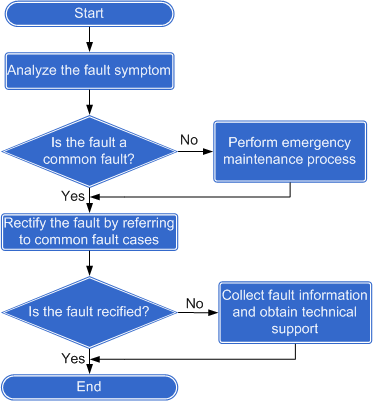Navigation: Fault Management > Troubleshooting Guide > Overview >
Before proceeding, learn the basic troubleshooting process.
Figure 1 shows the overall troubleshooting process.
Figure 1 Troubleshooting process

Table 1 Overall troubleshooting process
Operation |
Description |
Analyze the fault symptom. |
Determine the fault type and level according to the fault symptom. |
Determine whether the fault is a common fault. |
Determine whether the fault is a common fault or an emergency fault according to the fault symptom. |
Perform emergency maintenance. |
Find the fault cause and take proper measures to handle the fault by referring to Emergency Maintenance. |
Refer to the troubleshooting cases to handle the fault. |
Find the fault cause and take proper measures to handle the fault by referring to the troubleshooting cases. |
Check whether the fault is rectified. |
After the fault cause is determined and proper measures are taken, check whether the fault is rectified. |
Collect fault information and obtain technical support. |
If the fault cannot be rectified using methods described in this manual, obtain sufficient fault source information, fill out the Filling in the Fault Information Collection Template, and ask your service provider for technical support. |
Parent Topic: Overview